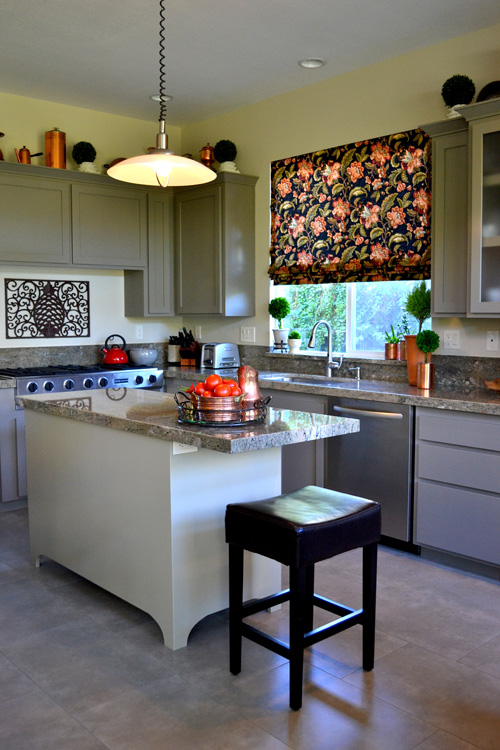
Have you ever noticed at holiday parties, one thing you can count on – folks will always gravitate to the kitchen, no matter what the size?
Many of us have fond memories of the smells, conversations, hearty meals and love that came from grandma’s kitchen. Well, the news is: kitchen design has changed a great deal since grandma’s days, with a focus on state-of-the art technology, convenience, beauty, ergonomics and sustainable materials. The rapidly growing trend of healthier lifestyles, along with homegrown organic food, is shifting plenty of attention to the kitchen. It has become the natural hub of entertaining, and now more than ever, the kitchen is truly the heart of the home.
Kitchens are by far the most expensive remodeling project you will encounter, so you will want to get this project right. Whether your plans are for a simple paint upgrade on your cabinets, a full-blown remodel or something in-between, here’s sound advice that will help you achieve the finest results. To begin, let’s learn from the mistakes of others; what are some the pitfalls?
The big offender
Too often, I see kitchens or bathrooms that just don’t fit the home. As soon as you enter, they smack you right in the face as ‘newly remodeled.’ If you could visualize the project out of that environment, usually it’s not a bad design. In fact, one could even say it was a nicely done. But instead, it interprets in the home as a strange misfit of materials and selections. When a remodel is well done, the newly remodeled room will fit the home like a glove. It will seem gently relaxed, fresh, fun, and transition with ease and grace.
More than just good taste
The language of materials, color and design is complex. Each color, finish and style conveys a language: formal, relaxed, modern, fresh, fun, dramatic, rich, elegant, edgy, masculine, feminine, whimsical, farm-style or country. A simple but excellent material example is polished granite, which conveys a strong message as a formal material due to the high sheen — and the rule of thumb is the darker the color of granite, the more veining, the more formal the statement. On the other end of the spectrum, a more casual choice might also be granite, but with a honed (matt) finish, in a light color, with very little veining and tight consistency in the pattern.
Each material we select communicates a message. And in the end, the combination of these selections will convey an instant mood when you enter the room. The top three most important questions you will need to ask are: How does this material relate to the rest of my home? How will this room ‘feel’ with this selection of materials
and colors? Do these materials and colors reflect the true personality of myself and/or my family?
Bring on the light
Have you noticed that most people natur-ally gravitate to a room with good light? Lighting is one area that most homeowners and even some designers make the fatal mistake of ignoring. A well thought-out lighting plan is critical for the success of your kitchen project. Imagine working in a large, well-lit prep area flooded with plenty of light. Know that this is money well spent. Plan to incorporate a combination of daylighting (natural light), task lighting and ambient lighting. Your new kitchen will absolutely come alive — instantly adding beauty and value to your home.
As author Nigel Slater said in his book, The Kitchen Diaries: A Year in the Kitchen with Nigel Slater, “Good kitchens are not about size; they are about ergonomics and light.”
Let it shine
Here is some final advice about letting your personality shine through. Although it may be tempting, don’t go for the first item that immediately ‘wows’ you. I can guarantee you will tire of it. Do have fun and express your personality in the areas that can be easily altered as your tastes change: paint, art, accessories — while keeping the dominant areas of the project (cabinets, materials, lighting) clean, simple, timeless and tasteful. In the end, you’ll be grateful you did. Your kitchen will become your new favorite place in your home; it will serve you well and stand the test of time with poise and grace.
About
Lorraine Alexander (above) has more than 25 years in the field of design. The hallmark of her work is material coordination and color. Committed to sustainable design and building practices, Lorraine chairs the U.S. Green Building Council Pacific Region and the Santa Rosa Junior College Interior Design Advisory Committee, and she is certified as a Green Building Professional with Sonoma State University.
Contact: 707-836-9060, in**@lo***************.com, www.LorraineAlexander.com.
Top 10 Designer Tips
1. Do your research well in advance. Know what products and options are available in the marketplace.
2. Make a wish list. Include ‘how you entertain’ and ‘your cooking habits’ – share these with your design team.
3. Set a realistic budget and buy the best quality you can afford. Setting the budget too low will only get you disappointing results.
4. Spend the time to select the perfect ‘dream design/construction team’ and hold at least one collaborative meeting in the front end of the project. Putting these professionals together to discuss the project has enormous benefits.
5. Get professional help from a designer that can coordinate materials and color that translate well in your home environment, and live with your selections for a few weeks before finalizing them.
6. Don’t go for the first item that immediately ‘wows’ you. I can guarantee you will tire of it.
7. Have fun in the areas that can be easily changed. Paint, art, accessories. Keep the design lines clean, timeless and tasteful.
8. Get healthy – Select sustainable, recycled materials when possible, and low or no VOC products. You and your family with breathe easier. Be wary of ‘greenwash’ products – those that claim to be ‘green’ but are not.
9. Focus on the ergonomics – If well done, this will make life easier and make cooking a joy.
10. Spend part of your budget on a quality lighting plan. Your project will come alive, instantly adding beauty and value.







